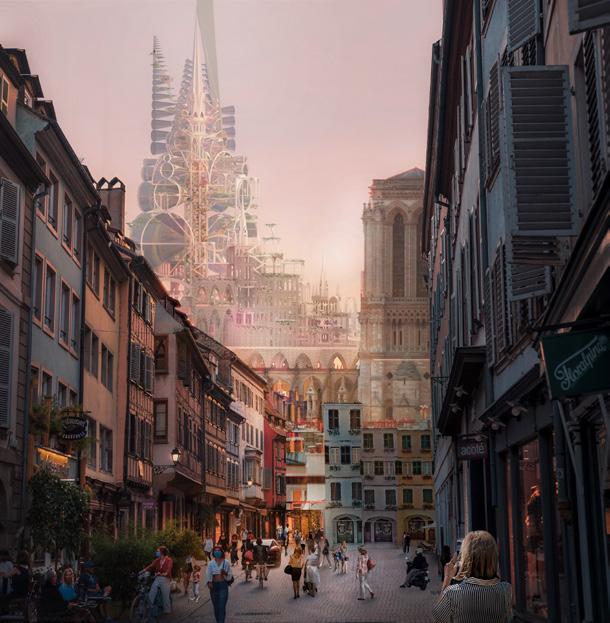
4 minute read
Chaoqun Lin
Chaoqun Lin
The Eden Fantasy
The new Notre Dame aims to mark a different way of praying. Instead of speaking with the unreachable God found in a classic church, prayers and visitors are now strolling in the dreamlike flower fields and having a spiritual conversation with God. They no longer feel monotonous and boring, but feel real baptism and relief.
Notre-Dame, the heart of Paris, the treasure of the Île de la Cité, has just suffered the most trying moments in its long history. Across all lands and cultures of the world, the fire leaves us speechless, touching the hearts and arresting everyone’s gaze. It reminds us all how much architecture, as indeed every artifact is a fragile thing. Notre-Dame is now the tragic proof that preserving our rich built heritage, the tangible traces of the great heights of craftsmanship that have been achieved, wherever they may be, is indispensable. This incandescent wound also reveals the emotional dimension carried by architecture and how its universal cultural value, its unique symbolic force, and its mythical dimension nourish the arts, literature, and every individual’s own. In the aftermath of the blaze that destroyed the roof of Paris’ iconic Notre-Dame Cathedral, The new design has envisioned a replacement “The Eden Fantasy” imagined a scene where architects from all over the world worked together to design this dreamlike building—the Garden of Eden, on top of the incomplete church. However, the authentic Garden of Eden was not created by architects but by people. Building co-creation. People spontaneously move in this building, creating a place spirit, giving up many desires, and returning to the ordinary. Under this kind of spirit’s catalytic action, the building blooms like a garden, possessing endless vitality. The mutual catalysis of architecture and people finally reproduces the Garden of Eden on earth.
The fire destroyed the cathedrals central spire and two-thirds of its roof, as well as parts of its vaulted interior. The construction of the cathedral is considered one of the finest examples of Gothic architecture in Europe. However, traditional gothic churches lie in cultural and historical contexts. They look remote and heavily in parallel to our daily life. The characteristics of a Gothic-style church are largely in congruence with the ideology that the more breathtaking a church is, the better it reflects the majesty of God. In order to liberate visitor’s perception and imagination, the New Notre Dame Cathedral has abandoned conventional forms as conceiving the absolutely serious structures and the embellished spatial design. At the same time, it captures the Old Church’s semiotical language in order to continue the symbolically manifested cosmological and theological concepts, with essential structural elements serving simultaneously as abstract design pieces. The New Norte Dame analyzes the different semiology and visual communication models, and captures the components of the Gothic elements, structures, and organization of the cathedral’s architectural form, and adopts the signs system’s logical structure within the cathedral in a new combination. The new design offers an illusion of immateriality by the open space at the top of the new church and Gothic architecture unit with the flowering facade. The greening wall is at once monolithic and imbued with fluidity due to the spatial hierarchy. The form and construction of the New Church is intended to echo lightweight provisional structures,
Wandering within the space, users get a clear idea of direction and become curious in order to go further into the higher floor to explore more of the church. By creating friendly spatial scales during the renovation and inserted a series of structures such as a walkway, corridor, small squares, and transitional yard to link with the indoor church and outside landscape to produce continuous, three-dimensional landscape experiences. The open design expands the field of vision, provides natural light all day, the indoor church as a second façade and offers views to the whole Paris. As a building in the landscape, the boundary between the outdoor and indoor spaces is blurred. This integrated design extends exhibiting space into natural settings, inviting visitors to appreciate the beauty of gardens in the natural. The Eden fantasy defines the New Notre Dame as a seamless, unlimited connection between home and garden - feeling peace. The design hopes to provide a new focus on self-awareness as architects, as well as extend the boundaries of architecture. Hereby extending the invitation for people to visit but also to discuss and contemplate architecture in general. This tectonic process will translate the scarcity of means into a particularly reductive quality of its architecture, turning it into a profound and sincere expression of a distinct architectural culture to re-bridge the relationship between people and the new church. Finally, this place’s unique energy is needed to be marshaled to restore to it an even more powerful presence, a wider resonance, transfiguring, amplifying, and exalting it into something else. The stakes regarding the future of this monument are unique. For Notre-Dame and its island must once again incarnate the beating heart of a city that has become a vast metropolis.














